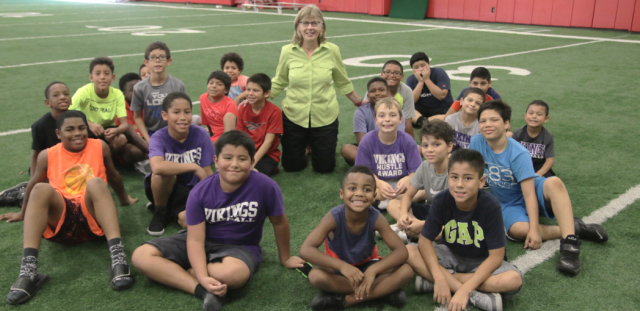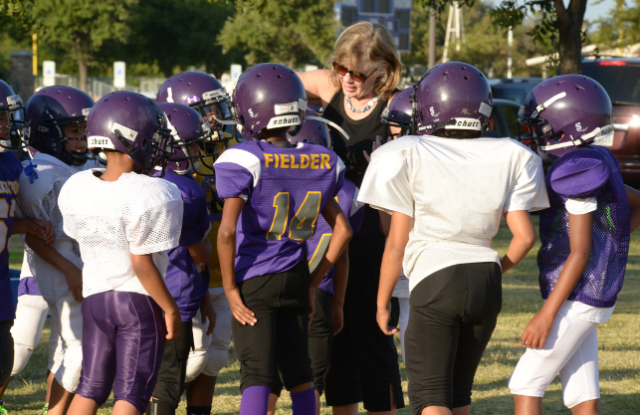Participation in youth sports in general, and in youth football in particular, is on the decline in some parts of the nation. One of the biggest factors driving the decline is a concern about injuries.
Lots of youth sports programs say they want to improve safety, but how many are actually making the effort to implement best health and safety practices?
I can't speak for every program, but I know one that is definitely walking the talk: the youth tackle and flag football and cheer program in Grand Prairie, Texas, where I spent the first week of August in 100 degree heat (the first thing I did when I arrived was to buy a pallet of water at a local big box store!) working with a group of leading experts I invited in to help educate and train 2,500 young tackle, flag and cheer athletes, parents, coaches, and administrators in the program on ways to make football and cheer safer as part of our MomsTEAM Institute of Youth Sports Safety's SmartTeamsTM | UNICEF International Safeguards of Children in Sports project.
What are some of the ways to make youth football safer? Here are ten specific steps I encouraged the Grand Prairie program, as an independent youth football program not affiliated with USA Football or Pop Warner, to take to provide a safer and more enjoyable experience for its players:
- Adopt
and periodically practice a comprehensive Emergency Action Plan: As I emphasized in my meetings with the Grand Prairie board,
one of the most important steps it could take to protect the safety of
athletes, spectators, coaches, and officials in case of a medical (serious
head, neck or spine injury, heat stroke\ or weather emergency (e.g. lightning, excessive heat) was to develop,
implement, and practice an emergency action plan (EAP). To emphasize the point,
we ran a mock emergency drill my last day in Texas. Because many youth sports programs, such as
Grand Prairie, lack the resources of school-based programs to pay a certified
athletic trainer to be at games and practices, I emphasized the need for Grand
Prairie to look for volunteers such as school nurses, RN's, LPN's, EMTs, or nurse
practitioners or medical doctors (either
parents with kids in the program or from the community) to help fill the gap.

- Strongly encourage parents to make sure their child has a pre-participation physical evaluation. In his presentation to the Grand Prairie parents, Dr. Jim McDonald, a pediatric sports medicine medical doctor at Nationwide Children's Hospital and Ohio State, encouraged them to make sure their child had a pre-participation physical examination, including the taking of detailed cardiac and concussion histories, even though a PPE is usually not required for participation in community-based sports. Experts agree that a PPE is the primary means of identifying athletes at risk of sports injury and initiating preventative measures.
- Teaches proper tackling and limit player-to-player contact during practices. As I did in 2012 while I was working with the high school football program in Newcastle, Oklahoma during the filming of my PBS documentary, The Smartest Team: Making High School Football Safer, I flew in Coach Bobby Hosea, the inventor of a revolutionary heads-free tackle training system now being used at all levels of the game, to teach safe tackling to the Grand Prairie players. To the naysayers who believe teaching kids to tackle without using their heads, or that sensible limits on full-contact practices at the youth level, can't make the game safer, a new study in the Orthopaedic Journal of Sports Medicine shows that they can significantly reduce the number of concussions, not just in practices (where, in contrast to other levels of football, most concussions occur at the youth level), but also in games.
- Makes
sure that all helmets fit properly, and that used helmets have been properly
reconditioned. An important
part of my week in Grand Prairie, as was the case in 2012 in Newcastle, was a
helmet fitting session in which an expert made sure that every player in the
Grand Prairie youth football program started the pre-season with a properly
fitted helmet and reminded coaches to check helmet fit periodically during the
season. I also made sure that all
helmets were reconditioned prior to the season in accordance with the helmet
manufacturers' recommendations, and also supplied thirty of the younger,
smaller players with brand new, lightweight helmets to evaluate (citing a lack of data, the National
Operating Committee on Standards for Athletic Equipment ("Nocsae") said in June 2015 that it had no current plans to issue a separate
performance standard for youth football helmets; look for a future blog on that
subject).

- Requires safety training. Most youth sports coaches are parent volunteers with little or no safety training. To fill that safety gap, I arranged for an instructor from the local chapter of the Red Cross to hold training sessions for Grand Prairie parents and coaches in first-aid, CPR and the use of an AED.
- Mandates comprehensive concussion education. As I discussed in a previous blog, state laws requiring concussion education do not always cover community- based and independent sports programs. I encouraged parents and coaches to take the free 30-minute online CDC Heads Up Concussion training courses, which MomsTeam Institute has endorsed. As a longtime advocate for mandatory concussion education meetings before every sports season, I walked the talk by flying in from Chicago a top sports concussion neuropsychologist. Dr Elizabeth Pieroth, to talk to the Grand Prairie parents and coaches about concussions, not just knowing the signs and symptoms but the importance of creating an environment in which players feel safe in reporting concussion symptoms to increase the likelihood that they will be immediately removed from games and practices.
- Has adopted conservative return to play guidelines. As required by law in every state for school-based sports, independent and community-based programs should require players to obtain written clearance by a medical professional with concussion training and expertise before returning to play. Many experts recommend that, because their brains are still developing, younger players should be held out of play longer than older athletes, some suggesting a minimum of three weeks after a concussion before returning to sports.
- Regularly inspects practice and game facilities. All programs should designate a parent or coach to regularly inspect practice and game facilities to make sure they are safe, including the cleaning of locker rooms to minimize the risk of communicable diseases (such as community-acquired MRSA. Athletes, parents, and officials should be encouraged to immediately report any unsafe conditions.
- Conducts detailed background checks of all volunteers and paid staff. It is every parent's nightmare that their child might be a victim of a sexual predator while participating in youth sports. Unfortunately sexual abuse of young players has occurred in youth sports leagues of all kinds, as well as with individual coaches in individual youth sports. Performing background checks on all volunteers is a powerful tool for protecting each player in your league. This safety measure is so important it needs to be required in all youth sports leagues.
- Follows the International Safeguards for Children in Sport. Adopted at the Beyond Sport summit in South Africa in 2014, the Safeguards are designed to help create a safe sporting environment for children wherever they participate and at whatever level, provide a benchmark to assist youth sports organizations and sports stakeholders to make informed decisions about safety, promote best practices and challenge practices that are harmful to children, and provide clarity on safeguarding children to all involved in sport. As the head of a pioneer organization designated by UNICEF UK to help implement the Safeguards in the U.S, I will be working with the Board of Directors of the Grand Prairie youth football and cheer program on an ongoing basis to implement the holistic and process-oriented approach to youth sport safety the Safeguards recommend.
I firmly believe that the best way to protect our children in sports is for an independent non-profit serving the interests of all youth sports stakeholders, not any special interest or group, to develop a program, such as we are doing with SmartTeamsTM, free to incorporate best practice recommendations from a wide variety of sources, including UNICEF, leading medical societies, and governmental agencies such as the CDC, adapted, where appropriate, for use by youth sports programs that lack the resources of school-based programs.
If more sports programs, like Grand Prairie, were to implement these kinds of safety measures, I am convinced that the safety concerns of parents would be assuaged and the decline in youth sports participation could be stemmed, even reversed.
During the next few weeks I will have more to say about youth sports best safety practices and what weare doing with SmartTeams , but, in the meantime, remember that to play safe, we need to be smart!
Note: This blog was first published on Huffington Post



















